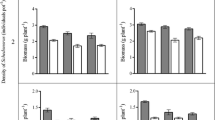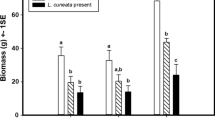Summary
We tested whether grasshoppers in experimental field environments, i.e. cages (40×40 cm) placed on existing old field vegetation, (1) were limited in density by plant abundance and/or nitrogen content, (2) exhibited interspecific competition, and (3) altered the relative abundance of different plant species. We examined interactions among a pair of early season grasshopper species (May–June; Arphia conspersa and Pardalophora apiculata) and a late season pair (July–August; Melanoplus femur-rubrum and Melanoplus bivittatus). Each grasshopper species was placed in cages by itself and with another grasshopper species. Grasshoppers generally survived at higher density in fertilized cages and they reduced plant abundance relative to empty cages, suggesting that grasshoppers may be food limited at these densities. In unfertilized plots, early season grasshoppers preferred grasses (Schizachyrium scoparium and Poa pratensis) and favored the growth of forbs (especially Solidago spp.). However, late in summer, Melanoplus spp. preferred Solidago spp. and favored the growth of grasses.
The pattern of grasshopper survivorship and plant reduction within these experimental environments provide preliminary support for some of the predictions of resource competition theory. Grasshoppers exhibited interspecific competition only if they significantly reduced plant biomass. If two species competed, a grasshopper species was eliminated only if the superior competitor, when living by itself, could reduce plant biomass to a significantly lower level than the inferior competitor. Competitors persisted only if they did not differ in their ability to reduce plant biomass or reduced the abundance of different plant species.
Similar content being viewed by others
References
Belovsky GE (1981) Food plant selection in a generalist herbivore: the moose. Ecology 62: 1020–1030
Belovsky GE (1984) Moose and snowshoe hare competition and a mechanistic explanation from foraging theory. Oecologia 61: 150–159
Belovsky GE (1986) Generalist herbivore foraging and its role in competitive interactions. Am Zool 26: 51–69
Bernays EA, Barbehenn R (1987) Nutritional ecology of grass foliage-chewing insects. In: Slansky F, Rodriguez JG (eds). Nutritional ecology of insects, mites, spiders, and related invertebrates. Wiley Press, New York
Bernays EA, Chapman RF (1970) Experiments to determine the basis of food selection by Chorthippus parallelus (Zetterstedt) (Orthoptera: Acrididae) in the field. J Anim Ecol 39: 761–776
Campbell JB, Arnett WH, Lambley JD, Jantz OK, Knutson H (1974) Grasshoppers (Acrididae) of the Flint Hills native tallgrass prairie in Kansas. Kansas Agric Exp Sta Res Paper 19
Chapin FS III (1980) The mineral nutrition of wild plants. Ann Rev Ecol Syst 11: 233–260
Evans EW (1989) Interspecific interactions among phytophagous insects of tallgrass prairie: an experimental test. Ecology 70: 435–444
Faeth SH (1986) Indirect interactions between temporally separated herbivores mediated by the host plant. Ecology 67: 479–494
Gwynne MD, Bell RMV (1968) Selection of grazing components by grazing ungulates in the Serengeti National Park. Nature 220: 390–393
Holt RD (1977) Predation, apparent competition and the structure of prey communities. Theor Pop Biol 12: 197–229
Hsu SB, Hubbell SP, Waltman P (1977) A mathematical theory for single nutrient competition in continuous cultures of microorganisms. SIAM J Appl Math 32: 366–383
Huntly NJ, Inouye RS (1988) Pocket gophers in ecosystems: patterns and mechanisms. BiScience 38: 786–793
Inouye RS, Huntly NJ, Tilman D, Tester JR (1987) Pocket gophers, vegetation and soil nitrogen along a succession sere in east central Minnesota. Oecologia 72: 178–184
Jarman PJ (1974) The social organisation of antelope in relation to their ecology. Behaviour 48: 215–267
Joern A, Lawlor LR (1980) Arid grassland grasshopper community structure: comparisons with neutral models. Ecology 61: 591–597
Joern A, Lawlor LR (1981) Guild structure in grasshopper assemblages based on food and microhabitat resources. Oikos 37: 93–104
Jonasson S, Chapin FS III (1985) Significance of sequential leaf development for nutrient balance of the cotton sedge, Eriophorum vaginatum L. Oecologia 67: 511–518
Lawlor LR (1979) Direct and indirect effects of n-species competition. Oecologia 43: 355–364
Lawton JH, Strong DR Jr (1981) Community patterns and competition in folivorous insects. Am Nat 118: 317–338
Levine SH (1976) Competition interactions in ecosystems. Am Nat 110: 903–910
Louda SM, Keeler KH, Holt RD (1989) Herbivore influences on plant performance and competitive interactions. In: Tilman D, Grace J (eds) Perspectives on plant competition. Academic Press, New York
McNaughton SJ (1983) Serengeti grassland ecology: the role of composite environmental factors and contingency in community organization. Ecol Monogr 53: 291–320
Mulkern GB, Pruess KP, Knutson H, Hagen AF, Campbell JB, Lambley JD (1969) Food habits and preferences of grassland grasshoppers (Acrididae) of the North Central Great Plains. North Dakota St Univ Agric Exp Sta Bull 481
Ritchie ME (1988) Individual variation in the ability of Columbian ground squirrels to select an optimal diet. Evol Ecol 2: 232–252
Robbins CT (1983) Wildlife feeding and nutrition. Academic Press, New York
Rothhaupt KO (1988) Mechanistic resource competition theory applied to laboratory experiments with zooplankton. Nature 333: 660–662
Schoener TW (1976) Alternatives to Lotka-Volterra competition: models of intermediate complexity. Theor Popul Biol 10: 309–333
Schoener TW (1978) Effects of density-restricted food encounter on some single-level competition models. Theor Popul Biol 13: 365–381
Sparks DR, Malechek JC (1968) Estimating percentage dry weight in diets using a microscopic technique. J Range Manage 21: 264–265
Strong DR Jr (1984) Exorcising the ghost of competition past: phytophagous insects. In: Strong DR Jr, Simberloff D, Abele LG, Thistle AB (eds) Ecological communities: conceptual issues and the evidence. Princeton Univ Press, Princeton
Tilman D (1976) Ecological competition between algae: experimental confirmation of resource-based competition theory. Science 192: 463–465
Tilman D (1980) Resources: a graphical-mechanistic approach to competition and predation. Am Nat 116: 362–393
Tilman D (1982) Resource competition and community structure. Princeton Univ Press, Princeton
Tilman D (1984) Plant dominance along an experimental nutrient gradient. Ecology 65: 1445–1453
Tilman D (1987) Secondary succession and the pattern of plant dominance along experimental nitrogen gradients. Ecol Monogr 57: 189–214
Tilman D (1988) Plant strategies and the dynamics and structure of plant communities. Princeton Univ Press, Princeton
Tilman D, Wedin D (1991) Plant traits and resource reduction for five grasses growing on a nitrogen gradient. Ecology 72: 683–698
Vandermeer JH (1980) Indirect mutualism: variations on a theme by Stephen Levine. Am Nat 116: 441–448
Wilson SD, Tilman D (1991) Components of plant competition along an experimental gradient of nitrogen availability. Ecology 72: 1050–1065
Author information
Authors and Affiliations
Rights and permissions
About this article
Cite this article
Ritchie, M.E., Tilman, D. Interspecific competition among grasshoppers and their effect on plant abundance in experimental field environments. Oecologia 89, 524–532 (1992). https://doi.org/10.1007/BF00317159
Received:
Accepted:
Issue Date:
DOI: https://doi.org/10.1007/BF00317159




